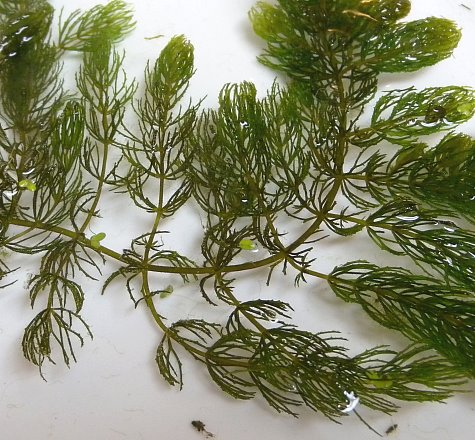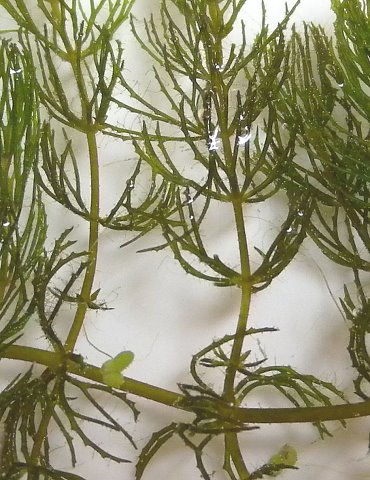
Coontail is monoecious, forming male (staminate) and female (pistillate) flowers on the same plant. Both types of flowers are produced in the axils of the leaves and they are sessile. Female flowers occur individually, while male flowers occur either individually or in pairs. Both types of flowers are very small in size (about 2 mm. in length), and they have involucres consisting of 8-14 floral bracts that surround the reproductive organs. These bracts are translucent and broadly oblong; their tips are truncate and fringed. There are neither sepals nor petals. Each female flower has a single pistil with a long slender style, while each male flower has 8-14 anthers that are sessile or nearly so (very short or absent filaments). The blooming period occurs intermittently during the summer and early autumn. Cross-pollination is accomplished through water currents. However, only a few flowers, if any, are produced by individual plants. The female flowers are replaced by 3-spined achenes. The body of each mature achene is 4-6 mm. long, ovoid in shape, slightly flattened, and wingless along its sides. Each achene has 2 basal spines and a single spine at its apex; these spines are 0.5-12.0 mm. in length and they are either straight or curved. Coontail has no real root system, although it is able to anchor itself in mud or sand through either lodged stems or the development of modified leaves. By late autumn, winter turions (tight buds of leaves) develop at the tips of stems that sink to the bottom of a body of water, where they remain until spring of the following year. Growth and development begin again with the return of warmer weather. In addition to its achenes and winter turions, Coontail reproduces vegetatively whenever its stems divide into smaller segments.
Cultivation: The preference is full sun and relatively clear water up to 9' deep that has adequate levels of nutrients; water pH can be mildly acidic to alkaline. At the water's bottom, the soil should consist of mud, sandy mud, or muddy gravel. Coontail is more tolerant of shade than the majority of aquatic plants and it is able to tolerate some turbidity in the water if it is not excessive. This aquatic plant can adapt to sites with either stagnant water or slow-moving currents where there is some protection from wind and waves. Because of its phytotoxic properties, Coontail can inhibit the growth of phytoplankton and blue-green algae (cyanobacteria). At some locations, it can spread aggressively and become a pest.
Range & Habitat: The native Coontail (Ceratophyllum demersum) is occasional to common throughout Illinois. This species is native to a wide area of North America, from where it has spread to other parts of the world. Habitats include quiet inlets of lakes, ponds, rivers with slow-moving currents, marshes, and springs. Generally, Coontail is typically found in bodies of water with muddy bottoms, although it also occurs where the water bottom contains some sand or rocky material. Sometimes Coontail is cultivated as an aquarium plant. It has also been introduced deliberately into polluted bodies of water in bioremediation projects because of its ability to absorb suspended particles of chromium, lead, arsenic, and other chemicals.
Faunal Associations: The leaves of Coontail (Ceratophyllum demersum) provide hiding places for small aquatic organisms and its leaves are sometimes grazed by snails. The aquatic larvae of a Crambid moth, the Water Veneer (Acentria ephemerella) feed on the foliage of this plant (Natural History Museum website, accessed 2010). Both the foliage and seeds of this aquatic plant are eaten by the American Coot (Fulica americana) and many species of ducks (see the Waterfowl Table for a list of these species). Turtles also feed on this aquatic plant, including the Musk Turtle (Sternotherus odoratus), Snapping Turtle (Chelydra serpentina), Blanding's Turtle (Emys blandingii), Painted Turtle (Chrysemys picta), River Cooter (Pseudemys concinna), and Slider (Trachemys scripta); see Lagler (1943) and Ernst et al. (1994). According to Pearse (1918), this aquatic plant is also eaten by a freshwater fish, the Pumpkinseed (Lepomis gibbosus). The foliage and seeds of Coontail can spread to new wetlands through human activity. For example, when people dump the content of aquariums that contain this aquatic plant into waterways, it can easily establish itself in such habitats. Similarly, because Coontail can cling to anchors, boat trailers, fishing nets, and dredging equipment, it may be transported considerable distances from one body water to another.

Photographic Location: In shallow water of a sandy marsh at the Heron Boardwalk in Vermilion County, Illinois.
Comments: Coontail (Ceratophyllum demersum) superficially resembles some Chara spp., even though the latter are actually algae, rather than vascular plants. This aquatic plant can be distinguished by its leaf segments, which have teeth along only one of 2 sides (rather than both), and its crushed foliage lacks the distinctive garlic or skunk-like smell that is so typical of many Chara spp. A closely related species, Spiny Hornwort (Ceratophyllum echinatum), is also found in Illinois, but it is less common. Compared to Coontail, Spiny Hornwort has softer foliage and its leaf segments either lack teeth or they have less conspicuous teeth along one side of their leaf segments. In addition, the achenes of Spiny Hornwort are shallowly winged along their sides, and each winged side of an achene has 3-10 spiny teeth. Although they have apical and basal spines, the achenes of Coontail lack spiny teeth along their sides. Another common name of Ceratophyllum demersum is Common Hornwort.